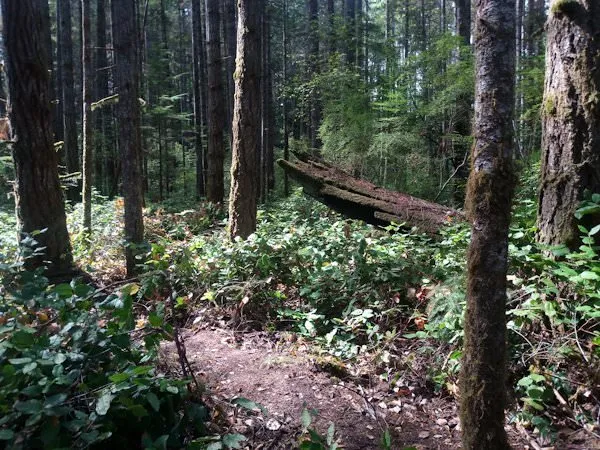
To explore and get to know the natural beauty of the region, one doesn’t have to venture too far from the Doighouse, the Earthship on Vancouver Island I am helping to build. In fact, now there is even a scenic little trail right on the property, thanks to my friend who doesn’t want to be mentioned in blogs. Whenever he was not busy on the build, he cleared a winding path through the woods, leading to interesting looking features. Many of them are stumps of huge trees that remained after a fire had burnt the land, a century or so ago. What started out as a short trail to these burnt stumps (hence the name), evolved into a loop of about a kilometer in length. Let me take you along on this picturesque walk, with the photos I took on this extended trail around the area cleared for the construction and the the garden.

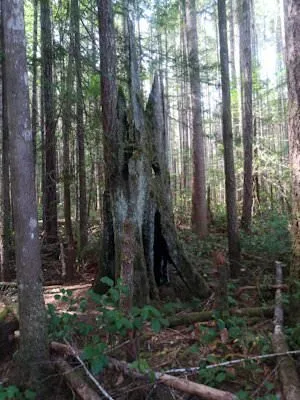
The trail starts out close to the entrance of the property, where Susan and Tony first cleared a spot to establish themselves, and loops around to the western extreme of the clearing. That is where the untouched part of the land offers a wonderful Zone 5, where nature can thrive without any interference.
Multi-Berry Heaven
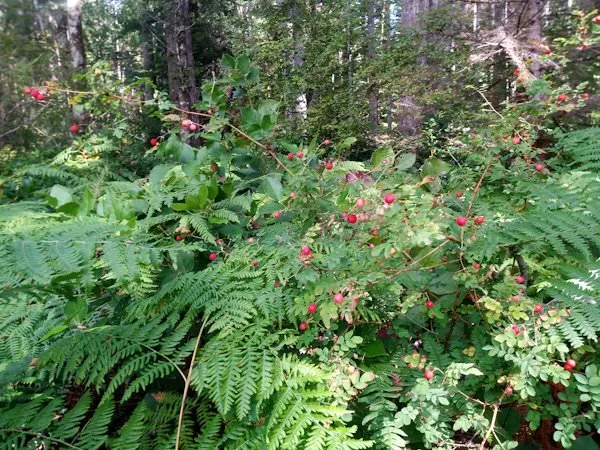
Right as we enter the trail, we are surrounded by a bounty of salmonberries (Rubus spectabilis) growing on tall bushes and native blackberries (Rubus ursinus) all around the forest floor. By now in late August, these berries have had their season, but for most of the Summer they were lovely snacking spots. As the trail winds itself deeper into the forest, huckleberries (Vaccinium parvifolium) become the most common berries. Occasionally we also pass by wild rose (Rosa acicularis) bushes and holly, while the edge of the footpath is lined with Oregon grapes (Mahonia aquifolium). The most common berries, however, grow on the salal (Gaultheria shallon), virtually everywhere among the trees.
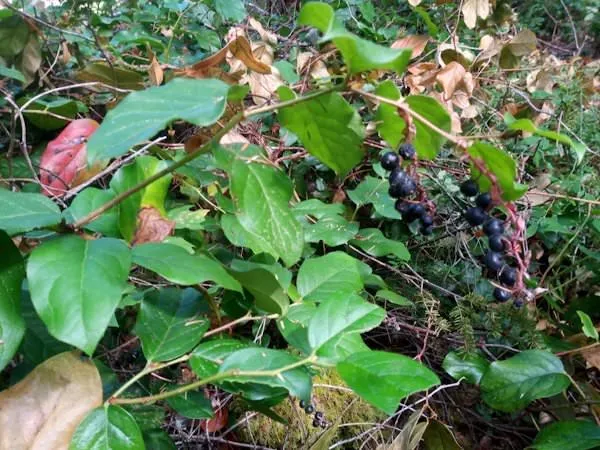
Over Sticks and Logs
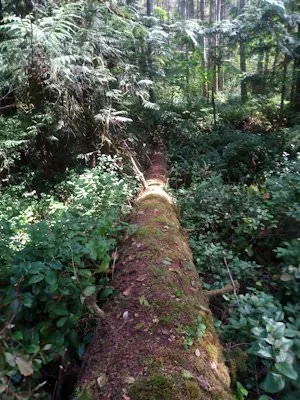
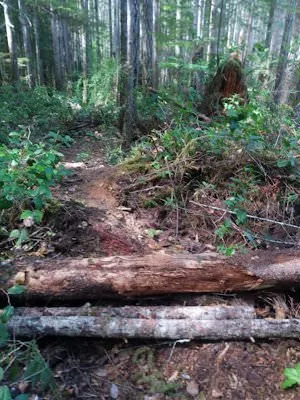
The trail makes use of the features of the place, such as fallen trees, to walk over the unstable areas of the forest floor. Though it’s been more than 80 years since the area had been logged, there are still parts where the floor is not clearly defined: fallen trees lying over rotting stumps, with more vegetation growing out of it. Thick logs can become ideal bridges when navigating through this wild growth, or even forming a bridge over the creek. Other times, the log just crosses the path, inviting us to sit on it, or climb over on our continued excursion.
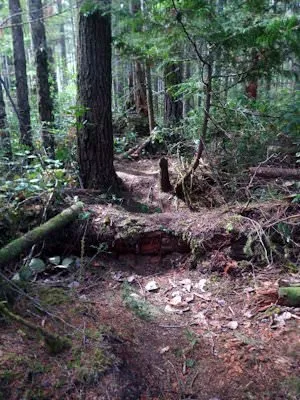
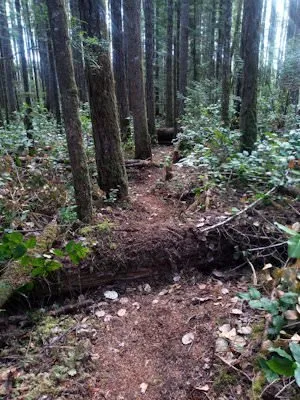
All the Local Giants
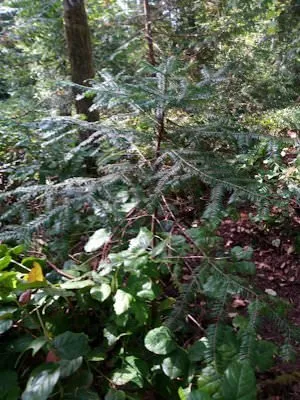
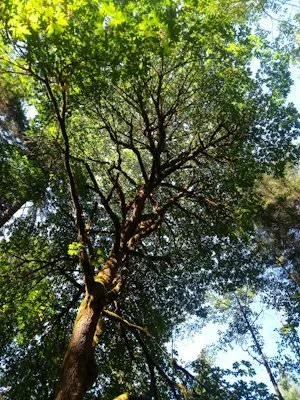
These woods are primarily made up of three trees: the Douglas Fir (Pseudotsuga menziesii), the Hemlock (Tsuga sieboldii), and the Western Red Cedar (Thuja plicata) though there are some Grand Firs (Abies grandis), Amabilis Firs (Abies amabilis), and possibly Yellow Cedar (Cupressus nootkatensis). I was particularly happy to find a small Yew (Taxus brevifolia) tree as well, right on the trail. One tree I haven’t seen here, is the Sitka Spruce (Picea sitchensis), but I’ve seen saplings just by the railroad tracks, so I might plant one in a nice spot on the trail. Among all these coniferous trees, there is also a deciduous giant, the Bigleaf Maple (Acer macrophyllum). Its enormous leaves form a lovely canopy, filtering the sunlight, and its trunk and branches are covered in thick moss. A smaller deciduous tree - possibly a dogwood (Cornus something) - has been a favorite among walkers of the trail, for its horizontal solar array.
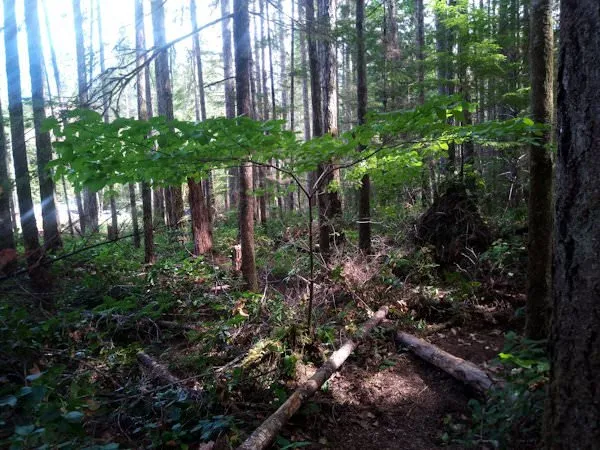
More Greenery in the Under-storey
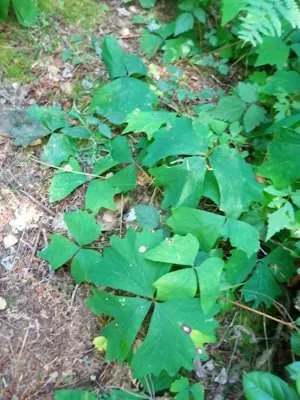
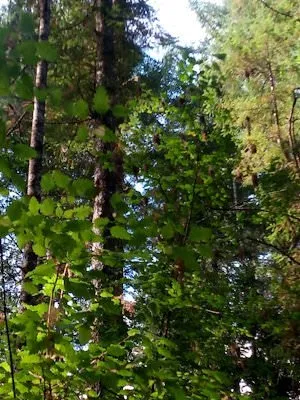
It has been fun accumulating information about many of these local plants. One such bush is the Ocean Spray or Ironwood (Holodiscus discolor), which native cultures used for making arrows. Another one is the Vanilla Leaf (Achlys), which had been used as an indoor air refreshener. Most types of the vegetation, however, are various types of mosses and ferns, which would take a separate exploration to really get to know.
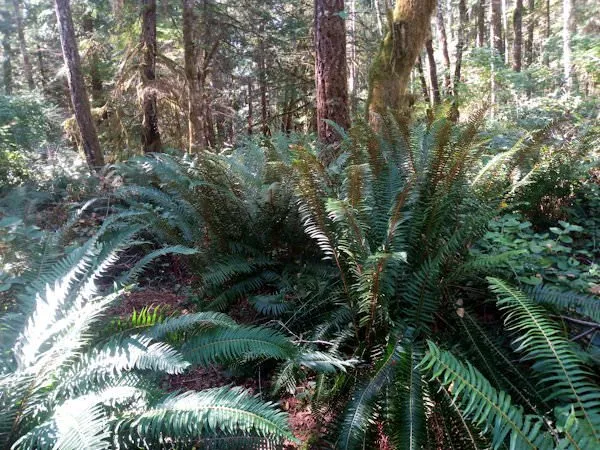
Forest Fungi, Wild and Domestic

You can’t leave a forest without mentioning the fun guys who are behind the whole thing: the mycelia weaving through the ground we walk on, connecting all other plants in a complex web… and occasionally popping out as mushrooms. Most of these don’t hang around for too long, and it hasn’t rained for quite a while. Sometimes you can be lucky, and see these dudes sticking up their purple fungus caps. Nevertheless, the area offers ideal conditions for mushroom cultivation, as Susan is making use of in her suspended mushroom logs. They happen to be right on the trail too, or rather, the trail passes by where we suspended them. Once ready, these logs are going to flush with Shiitake (Lentinula edodes) and Oyster Mushrooms (Pleurotus).

At the moment the Burnt Stump Trail is just a curious little feature on the Doighouse property, where the owners can enjoy a relaxing stroll. But with time Susan would like to include it in the learning center, with labels on the plants and interesting tidbits of information, introducing the forest to visitors. Just as everything else around this project, it has some wonderful potential, and I’m excited to see what it will look like in a few years. I’ll be sure to come back to visit.
If you like this project, please visit the other posts I have published in my Doighouse Series:
- Earthship and Permaculture - Introducing the Doighouse Series
- Shower for the Earthship Build
- Complementing the Earthship: The Permaculture Garden
- Essential for the Helping Hands: The Volunteer Kitchen
- Preparing for the Earthship Build: Milling Lumber
- Week of Volunteers - Getting Started on the Tires (finally!)
- The Most Annoying Part of the Build: Satisfying the MAN
- Official Clearance – Building Permit and Inspections for the Doighouse
- Field Trips from the Doighouse
- Getting Wrapped at the Doighouse Build
If you're interested in coming to visit, or better volunteer for a while, please contact Susanmdoig@gmail.com and visit http://thedoighouse.com/ Looking forward to getting to know you!
Please check out these great communities I'm contributing to:

#homesteadersonline | Website | Discord Community

#ecotrain | What is EcoTrain | Discord Community

#cyclefeed | Introducing CycleFeed | Discord Community

Introducing SteemitDreamit | Facebook Group | Discord Community